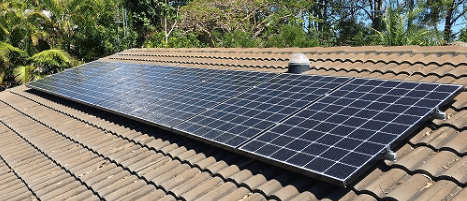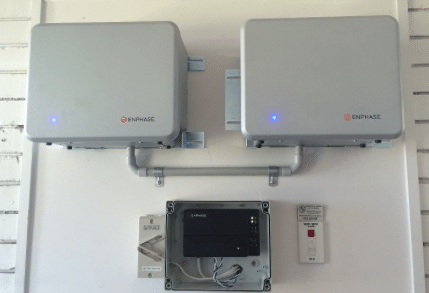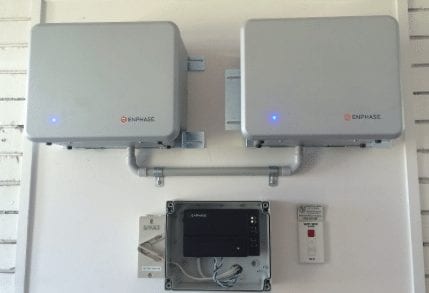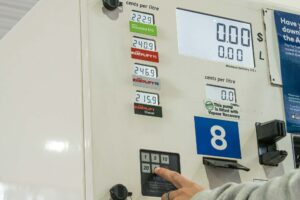
Finally, a little over six months after I moved into a home (not newly built, just newly bought), I have – for the first time – a combination of rooftop solar and battery storage.
It’s exciting. So much so that I spent most of the October long weekend staring at the monitoring devices noting the amount of solar produced and what the batteries were doing, and offering advice about when everyone should take showers, switch on lights or operate appliances.
I’m told I’ll get over that soon. But here are a few thoughts about the first two weeks. I’ll write some more as time goes on and I understand the systems better.
As I wrote before, my previous house in Sydney may have felt something like a wooden tent, but it didn’t consume a lot of electricity (mostly because it wasn’t used for heating or hot water).
This new house, in the northern rivers of NSW, is an electric utility’s wet dream – electric hot water provided by the equivalent of an old kettle that keeps the coal-fired power stations busy at night, and daily usage of at least 15kWh for two and up to 30kWh a day with visitors.
That was until a few weeks ago.

That was when 5kW of LG 315 Neon2 panels were installed (8 panels or 2.5kW facing east, pictured above, and another eight panels or 2.5kW facing west – I don’t have much north roof space), and two of the newly launched Enphase AC battery storage systems (pictured left).
Why go for these brands? Well, frankly, it’s because I got a good deal (thanks to my friend Nigel Morris at RoofJuice).
But I do know they are both top of the range. And quality, for assets that will sit in the garage for 10 years and on the roof for several decades, is important. It would have been possible to get cheaper modules, and cheaper batteries. But the question is, would they last?
I like the idea that the new LG panels (315 watts) are powerful enough to mean they don’t actually take up much roof-space, and if I want to expand – to go off grid some time down the track or power an electric vehicle – then there will be no problem. (LG solar panels are heading towards 360 watts and then maybe even 400 watts).
I chose Enphase micro-inverters: First, because of the quality – I have heard too many horror stories about cheap inverters packing up after a few years and no one around to take responsibility. Also, because I get a little shade from gum trees east and west, particularly in the morning and late afternoon, this helps optimise the PV system’s output.
For the batteries, well, I’m kind of intrigued. There are a lot of offerings out there that seem good quality, but some of them are serious chunks of money ($10,000 or more). I liked the idea of a modular system where I can start small, get to know my solar production and consumption habits, learn what battery storage can do, and then see if I want or need to add more.
I already had a pretty good idea of what my consumption looked like, thanks to the monitoring device I got through Solar Analytics. It is still surprising that so many households have no idea how much various devices consume, or how their solar systems are performing.
Even before I got the solar on the roof, I learned a lot about my consumption patterns, and the power needs of the various appliances, including the giant kettle that passes for a hot water service, the real kettle for hot water, the electric oven (we have no reticulated gas up here), the pool pumps and the water pumps (we have no mains water either), and the septic system (we are off grid for that too).
This is what a really ugly day looked like before solar and storage. Check out that hot water on the left. Total consumption that day was more than 25kWh (though some days went beyond 30kWh), total consumption for the week was 150kWh, and a bill just shy of $50/week, heading for $2,500 a year. Ouch.

So, what have I learned in the first weeks of my solar and storage? First of all, solar is around one third of the the price of grid-based power. I produce it and it’s clean. I haven’t crunched the numbers on the storage yet, but when I’m paying 34c/kWh for grid power, and many others are paying twice that amount, there’s a fair bit of room to play with.
All up, on a fine sunny day I am producing more than 30kWh, and that will rise into summer. On a really cloudy day, I am still generating around 9-10kWh. Even on a rainy day, the LG panels and Enphase micro-inverters are still good to generate around 6kWh.
The battery storage – even two small 1.2kWh units like the Enphase ones – are keeping my house powered through to past midnight if they finish the day fully charged, and even up to 6am on one occasion.
(That is with the exception of the real kettle and the electric oven, which cause spikes in consumption not met by the storage. But hey, I’m paying $500 a year for access to the grid, so I might as well use it).

The Enphase batteries don’t take a lot to fill, and they charge and discharge at a maximum of 270 watts each. That gets dissed in some quarters as being not enough.
But with two units, 540watts is enough for lighting and TV etc. When I take out the electric hot water, my consumption will likely be all but invisible to the grid on most days, but for the kettle and the electric oven, and random visitors with hair-dryers.
Yes, I could capture more solar and put in a bigger box for later use, and I might just do that, by adding another one or two units. But I will check out the usage over the seasons before doing so.
But it underlines the attraction of a modular storage system, remembering that according to some analysts it is the first kilowatt hours of storage that are the most valuable. (And, according to installers Tim Hodgson and Mark Hickey from Light Touch Electrical, it was the easiest battery storage installation they had done to date. And they have done a few. It was, they said, almost literally, plug and play.
Even with this amount of storage (and of course this amount of solar) I’m expecting my bills to all but disappear, but for the fixed network charges, which in this part of NSW are a whopping $1.50 a day! That’s $500 a year. As I learn more, I will get a better fix on my return on investment.
 The Enphase system also comes with its own monitoring device and displays, called Enlighten, which indicate performance of each panel, and the state of charge for each battery. I think this is absolutely crucial – I see so many people with solar who have absolutely no idea how their equipment is performing.
The Enphase system also comes with its own monitoring device and displays, called Enlighten, which indicate performance of each panel, and the state of charge for each battery. I think this is absolutely crucial – I see so many people with solar who have absolutely no idea how their equipment is performing.
I will go into this further at a later date, but here is taster of what you can see (to the left). It’s taken at 10pm, over a quarter hour period.
So what are my overall reflections at the end of the first weeks?
I wish I had done it quicker – it would have saved me around $40/week. I suspect my power bill, particularly in summer months, will fall to around zero. Yet to see for winter.
Even with a small amount of battery capacity, I am almost invisible to the grid, at least for consumption. I’m paying a hefty fee ($500 a year) to basically use the grid as a bigger-back up battery, and to export my excess solar.
In 10 years time, with the cost of storage going down significantly, and the cost of solar also falling, the network is going to have to make a compelling offer to compete with these technologies. Fortunately, the local council here appears serious about the concept of developing micro-grids and sharing energy.
Like most people, I like the idea of an electric car, when they come down in price. This solar, which is going to last for at least 25 years, will be able to provide much of the power to charge those batteries.
This article was originally published on RenewEconomy sister site One Step Off The Grid. To sign up for the weekly newsletter, click here.








